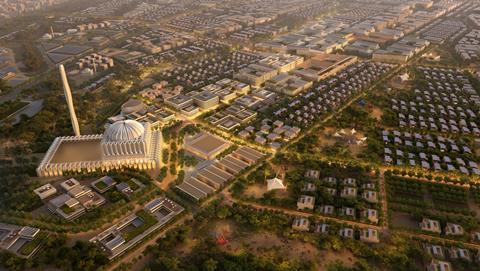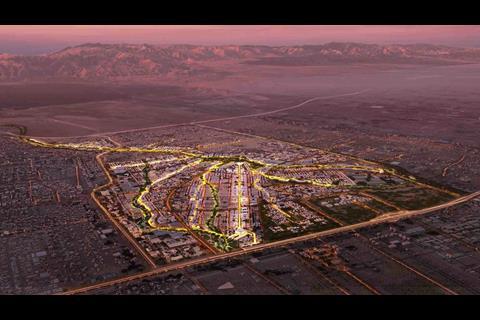Sultan Haitham City will have a population of 100,000, 39 schools and 24 mosques
Skidmore, Owings & Merrill has worked up masterplan proposals for a smart city in Oman that will eventually host a population of 100,000.
Sultan Haitham City is earmarked for a site to the west of the Omani capital of Muscat and will cover a total of 14.8sq km.
The Omani government said the new city had been planned to “reflect sound and sustainable urban planning” and would have 20,000 homes, ranging in size from villas to semi-detached houses, townhouses and flats.
It said the city would comprise more than 19 integrated neighbourhoods and that there would be 11 health facilities, a 1,200-bed referral hospital, a private hospital and elderly-care facilities.
Sultan Haitham City – named after Haitham bin Tarik, sultan and prime minister of Oman, will also have shops, 39 schools, a university and 24 mosques. It will feature 2.9sq km of green space, including a park along a stretch of dry river that will be used to contain floodwater.

SOM senior associate principal Bernhard Rettig, who is based at the global practice’s London offices, said the city’s “smart infrastructure” would be used to “monitor environmental factors such as air quality and water management.”
The proposals form part of the Oman Vision 2040 strategic plan. They include a traffic management system that will use real-time data from cameras and speed sensors to reroute vehicles and control traffic flow.
SOM said the masterplan was designed to “minimise” the smart city’s “ecological footprint” and would include solar energy facilities, waste-water recycling, electric vehicle infrastructure and waste-to-energy plants.
Work to deliver the first phase of Sultan Haitham City is due to start next year for completion in 2030. Three further phases, expected to run until 2045, will be required to complete the project.






















1 Readers' comment